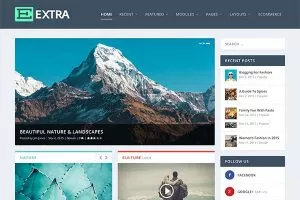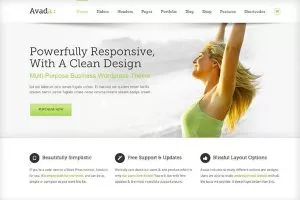If you are reading this text, you will likely want to start a travel blog. Great! Maybe I’m thinking about how you can travel more, how to share these trips in an exciting way; who knows until realizing the dream of a day to live the trips – and to create a blog seems a good idea to reach those objectives. I agree: it’s a great idea! But it is not easy.
I do not usually write about what’s behind the blog itself – Traveler’s Soul is a space about travel, not blogging. But more and more people have asked me what to do to start a travel blog, and I wanted to have a way to explain the process. In response, I have prepared this practical guide.
After 15 years of experience as a travel blogger, I hope with this guide to help all travelers and lovers of writing and photography to enter this wonderful world of the blogosphere.
The guide is a bit long (or full, if you prefer) and is divided into seven sections. Each one addresses a specific aspect of creating a blog – from hosting to graphics, starting with a deep understanding of what it’s like to be a blogger. Here’s all you need to know to start a travel blog.
Let’s do it.
1. Understand the work of a travel blogger
For many years, when they asked me what I did, I had difficulty answering. No one would understand if I said I was a travel blogger; in fact, I was not myself. It said that everything I did professionally was “linked to travel and to write”; and then explained that he had a travel website and a travel leader who gave writing workshops. It was true, but he needed to stop being ashamed to use the word blogger.
Not now. I’m saying I’m a travel blogger.
Becoming a blogger, be it amateur or professional, is the first step for people to respect the blogger’s work. To take him seriously. So you understand that it works hard. That the texts are not written by magic, nor the edited photos. That’s not all pink, tropical beaches, and bikini girls with cocktails in their hands.
Yes, managing a travel blog involves working many more hours than most people with a “normal” job. And without ever knowing what the return of this work will be.
Why, then, do I and a few others make life travels? Because we are happy. Score. It gives work, but I did not change my lifestyle for any other.
Things You Should Know Before Becoming a Digital Nomad
You know you have all my support for creating a travel blog. The purpose of this “How to start a travel blog ” is the same: help you. But before you start, it’s essential to be aware of a few things about the life of a blogger.
(get ready to read things you will not like)
It will not be easy
Most people who try to blog to make money give up in less than a year. Yes, it will likely take a long time to start making money from the blog. It will have to be original to distinguish itself. You’ll have to be persistent and patient. It will not be easy!
Are you working day and night?
Managing the blog will work more than in any other job you have ever had. The good news is that you can do it from anywhere in the world, in any environment (as long as you have Internet access): whether in the comfort of your own home or a bungalow on the seafront of a beach in the United States.
Your office becomes a laptop – and that’s fine. But the weekends and the free time are over because you’ll want to enjoy every minute of your blog.
Being a blogger is not just about writing.
You may not believe it, but only a tiny part of the blogger’s work was spent writing. It will take a lot of time to respond to readers’ comments; respond to email messages to refuse “partnerships”; feed social networks; deal with technical aspects of the blog; install plugins; Think about SEO (Search Engine Optimization); to change the look of the blog; to think, to experiment, to err, to innovate … and to plan the next trip.
You will also write, edit photographs, and publish the contents in the middle. But do not think you must register to be a travel blogger.
You have to invest to succeed.
Managing a blog is like running any other business: it is easier to succeed if you carefully invest your money. These are little things that can make all the difference.
Most of the issues I board can get resolved for free. Even when it comes to specific technicalities like plugins for WordPress, there are free versions that are sufficient. But many others do not. If you are fully committed to succeeding in the world of travel blogs, sooner or later, you will need to invest in tools that make it better. For example:
- You will look for specialized hosting such as Fully Managed WordPress Hosting, which guarantees speed, security, and professional support services to help you solve problems;
- You’ll choose a premium theme from well-known companies, such as Studio Press themes or Elegant Themes;
- You will buy the premium version of some fundamental plugins for blog success;
- And it will create a mailing list managed by the professional tools of AWeber or, preferably, Mailchimp.
Do not worry if, for now, you do not quite understand what I’m talking about. I will explain everything step by step below (in the case of the mailing list, I will address the subject in a text entitled Mailchimp, the best tool to manage email marketing for your blog. But do already with the idea of starting blog travel implies investing some money.
Holidays (as you know them) are over.
You will continue to have vacations, of course, but whenever you travel, you will want to take advantage to make a few posts. And that’s not bad, on the contrary. But be aware that, from the moment you start a travel blog, you will want to write about your travels (this is the essence of a blog).
Travel is no longer just a vacation and becomes a raw material for producing texts, which means work. Do not be scared … but be aware of it.
2. Set the type of blog
In the beginning, and even before any post exists, it is not easy to define what the blog will be. But the sooner you know exactly what you want to do, the easier it will be to create an audience that identifies with what you write.
Choose a niche that you will love.
For me, at this moment, since the blogosphere is flooded with travel blogs – the best advice I can give is to choose a niche. Do not just create one more generic blog about your travels. Be creative. And become a reference in this niche.
For example, specialize in so-called luxury travel if you love five-star hotels, luxury cruises, and restaurants. Do not mix these luxurious experiences with, for example, a backpacking trip. Do not you think it would be confusing for readers to have a post about traveling alone and hitchhiking in Italy followed by another on a luxurious honeymoon, two in the best resort of Bora Bora? You would be writing for what audience?
Write about budget or luxury travel, but not both at the same time. Write for young people looking for inspiration for a year gap or mature travelers with other interests and another style of travel. Write about traveling with children or about the experiences of a young backpacker traveling alone. Create a bike travel blog, but do not give in to the temptation to report a cruise you did in the meantime. Do you understand?
That is, choose a niche and stay as faithful as possible to it. Ideally, one should be passionate about the subject and imagine that it will remain comfortable on that skin in a few years. Do you love cycling? Great, write about it. In short, choose a travel style, a location, or a specific theme … and make a choice.
It is only natural that at the beginning, it is difficult to define your niche, style, and what you love. But one thing is sure: sooner or later, you will have to do it. And the sooner you do, the better.
An example of a niche I find brilliant is the blog of Kash Bhattacharya. The blog is called Budget Traveler, but it is not a regular blog to help backpackers travel with little money. Instead, Kash specializes in “cheap travel with style.” He created, among other things, a guide to the best luxury hostels in Europe, a seemingly contradictory concept that fits perfectly in the blog’s niche. And so, it differed from the rest.
City blog: an excellent idea for those who travel little
You probably have guaranteed that to have a travel blog, you must travel a lot. But this is not always true (there it is, it depends on your niche).
Some of the most successful travel blogs in The United States do not report travel properly. They fit into the category of city blogs and speak almost exclusively of a specific destination. As a rule, Americans living in Europe have created blogs dedicated solely to their adopted city.
If you cannot travel much for personal, family, or professional reasons, creating a city blog is an excellent option.
But you must decide this as soon as possible; if you do it from the beginning, it will help you focus on the blog’s primary purpose and not disperse energies.
Knowing what kind of blog you want to do, it’s time to choose a good name.
3. Choose a name (unique and memorable)
Choosing the name of the blog is fundamental. In an increasingly saturated world of travel websites and blogs, yours must stand out from the crowd. For this, you have to be creative.
Gone is the time when it was paramount to have the keywords in the name and address because of SEO (search engine optimization). Now, increasingly, the important thing is to be creative and choose a memorable character. In my opinion, a good reputation must have three fundamental characteristics:
- Be short and simple;
- Be original and unique;
- Be durable (not “trapped”).
Short and simple name
A name like “John’s Year Trips Around the World” is a lousy name – being able to break all the ground rules for creating the blog’s name. “I’m going there, and I’ll be right back before it gets dark” has the advantage of being original, but it’s still awful. Both have in common the fact that they are huge names. Simplify! Choose a short term.
An original and memorable name
What do you think of “Backpacker in the World” or “The Travels of Augustus”? They seem trivial and not very memorable—the opposite of what is needed nowadays: creative names.
For example, Chicken or Pasta is a name that has nothing to do with travel; but everyone who travels immediately associates it with the food of an airplane. To me, he puts a smile on my face. I find a brilliant example of a unique name for an English blog. More examples? Here are other successful and easily identifiable blogs: Bacon is Magic, The Planet D, The Blond Abroad, Migrationology, Roads & Kingdoms. Or, in another register (they are travel guides, not blogs, but serve as examples of names in the memory), Balkanology and Caravanistan.
That is, choose a name that has to do with you and your blog’s niche but avoid using too many words, such as nomad, traveler, hobo, backpacker, wanderlust, and the like. I know that one of the most successful travel blogs is Nomadic Matt, but when Matt Kepnes started his blog, the concept of “nomad” was far from saturated. In the background, be creative.
Long lasting name
Imagine Catarina, known as Katy, will study or live half a year in Auckland, New Zealand, and decide to create a blog to share the experience. “Katy in Auckland” is a sure name, correct? Wrong. I call it a trapped name, which will “trap” it into the future.
I explain.
The name may be great for those first six months by quickly identifying the object of the blog (Katy’s stay in Auckland). But what if, at the end of that time, Katy moves to Tokyo, Japan? Or decide to travel the world? The name no longer makes sense! Most likely, the blog would have to be renamed to remain a mirror of reality, and Catherine would have to start over from scratch to create a new “brand.”
The same happens if you do, for example, a motorhome trip in South America and decide to give the blog a name like “Caravan for the Americas.” And then, when to change continent or mode of transportation, will the name of the blog change? Or are you planning to create a blog for each trip? It would be a gross mistake.
In short, choose a firm name with a strong identity that reflects your travel style, but do not attach it to a geographic location (except in the case of a blog about a specific destination) or a set time (unless you do not want to continue to feed the blog at the end of this period).
In short
- Choose a short and simple name, original and memorable, with a thought for the future. In other words, be creative and avoid things like:
- “Backpacker in the world” (it is too generic, has no creativity, and says little about its identity, besides traveling backpack);
- “Alone on the globe” (it’s a trapped name: if you get a mate or fellow traveler and start traveling for two, will you change the name?);
- “Anita in Qatar” (attaches to a location – unless the goal is to create a city blog, in which case the idea would be acceptable);
- “Cycling through Asia without a penny in the pocket but a lot of desire to travel” (besides many other drawbacks, it is too big).
Now that you have an idea and a name let’s implement it …
4. Choose a hosting plan that fits your requirement (and install WordPress)
If the technology scares you a bit, you probably think that creating a blog is very difficult. It is not. Follow these steps.
Which hosting provider to choose to host the blog?
There is no going back. If you want to create a travel blog “seriously,” sooner or later, you will have to hire a hosting package that suits your requirement. I’ll try to help you with this task.
There are hundreds of possible hosting companies, but it is essential not to choose a company just because the service is very cheap. The day you have a severe problem, your blog is down for hours, technical support cannot help you answer your questions, or worse, if the servers are not secure and some hacker destroys months or years of work, you’ll regret this option.
If you want to take your blog to a level of seriousness, choose a hosting company with a good reputation.
To get started, choose the Starter plan. In the first phase, there is no reason to invest more money.
Save
If you have not yet registered your domain, this is the right time. I recommend using a “.com” extension.
Save
And that’s it, just make the payment, and you are ready to move ahead!
Install WordPress
One of the biggest mistakes I made in the whole history of my travel blogging was not to start using WordPress as a Content Management System (CMS) right from the start.
First, the blog was manually programmed in HTML and PHP. And then, when I turned the site into an actual travel blog around the time of my first round the world, I chose Movable Type instead of WordPress.
Nowadays, this is a non-subject. WordPress is the platform leading travel blogger on the planet and is arguably the best for almost every type of blogging.
Installing WordPress is very easy. Depending on your chosen host, it can even be done with a simple click. If you host the blog on Nestify and choose the Managed WordPress Hosting plan, you will not even need to install WordPress, as it comes by default in the hosting plan.
With the hosting and WordPress installed, it is now necessary to choose a theme and later deploy it with some plugins.
5. The graphics aspect of the blog
Simplistically, it is called the theme of blog design. The graphics aspect of a blog created with WordPress is determined by the theme used, so choosing a good theme is a process that should not be overlooked when starting a travel blog (a soberer and institutional style, or more informal and fun …).
How to choose a theme?
For travel blogs, I generally recommend:
- themes in magazine format (pieces designed for digital magazines and blogs);
- or multipurpose themes (designed pieces to cover all types of sites, not specifically designed for blogs but have great flexibility and many graphics resources).
Among the topics in magazine format, I prefer the modularity of the Genesis framework from Studio Press. It is the best platform for SEO but is best used by anyone with some programming knowledge, namely CSS and PHP. I use it on my blog in conjunction with the Magazine Pro theme.
Another exciting option is the themes from Elegant Themes, especially the Extra, of the endless possibilities that allow in graphical terms.
Finally, suppose you do not want to use Studio Press themes or Elegant Themes (two great companies I am a member of for life). In that case, I recommend Theme Forest instead – thousands of other WordPress themes are available for excellent quality and proven success.
In particular, here are some of the most popular topics for travel blogs:
Magazine Pro

Magazine Pro is the theme I currently use in Traveler’s Soul. Although visually very minimalist, I recommend it with no restrictions. In any case, before deciding to see the other themes of Studio Press and choose the one that most fits your blog idea. For example, for foodie blogs, the Foodie Pro is excellent. Studio Press themes are among the most prestigious on the market. + info
Extra

Extra is a theme of Elegant Themes, which I trust 100%. It is graphically very versatile and stylish, especially suitable for the most creative bloggers. A good bet for recent blogs. + info
Espresso

Espresso is a magazine format theme that is widely used in travel blogs. If I were not such a fan of Studio Press, I would be a serious candidate for this blog. + info
Avada

The Avada is the most significant selling theme of all time in Theme Forest, and that says a lot about its potential. It’s a generalist theme, not specifically designed for blogging. + info
6. Essential Plugins
The plugins are tools that allow you to expand the functionality of WordPress without the need for programming knowledge. Among the most frequent uses is the automatic detection of spam comments, the creation of contact forms, the use of caches to increase the blog speed, or tools linked to SEO (Search Engine Optimization).
Throughout my blogger life, I’ve tried many hundreds of plugins. I regularly use about 30, some of which I consider fundamental in any travel blog. Install them as soon as possible.
Akismet
Akismet is the best and most used method to filter spam on your blog. Required installation (free for personal blogs). + info
Captcha
To prevent lousy access by the brute force method, installing a manual confirmation system in WordPress login is convenient. I recommend the Captcha plugin (free) to do it quickly and effectively. + info
WP Smush
The “weight” of images is one of the main factors for many travel blogs being too slow. To combat this scourge, some plugins minimize the size of ideas without noticeable quality loss. Highly recommend the WP Smush (free with restrictions). + info
Yoast SEO
The earlier you pay attention to SEO (Search Engine Optimization), the better for your blog. Even if you do not have SEO notions, install the accessible version of the plugin right away. Afterward, I recommend installing the Premium version, but for now, there is a free version with which you can start (for many years, I have used the free version). + info
To install a plugin, go to your WordPress dashboard, and click on the “Plugins / Add new” option in the menu on the left.
The following blog series texts mention other more advanced plugins whose installation I also recommend. For now, let’s stick with these.
7. Type, type, type
I have already written that only a tiny part of the work of a travel blogger is dedicated to writing. It is true. But that small part is critical to success. The content you produce will be your brand image for good and evil.
Now that the blog is set up, it’s time to start producing quality content. In the second part of this series, I begin precisely by addressing the content issue.
Summary: How to start a travel blog
Critical Steps to Starting a Travel Blog:
- Choose a unique and memorable name;
- Host the blog in professional hosting service;
- Choose a Studio Press premium theme (like Magazine Pro), Elegant Themes Extra, Espresso, or Avada ;
- Install fundamental plugins like Captcha, WP Smush, and Yoast SEO;
- Write quality content.
If you’ve completed all the steps in this guide to start a travel blog, it’s time to move on to the following article in the How to Create a Success Travel Blog series.
How to Create a Successful Travel Blog?
This article is part of a series of posts written to help you build your blog and, who knows, live from travel and writing. To know:
- How to Start a Travel Blog
- How to structure the contents of your travel blog
- SEO, tips to improve the ranking of your posts
- Using the social networks of a travel blog
- Other advanced information to improve your travel blog
- How to make money from a travel blog



